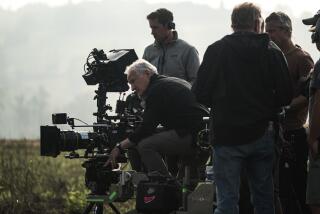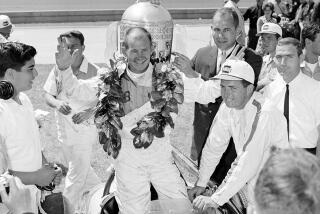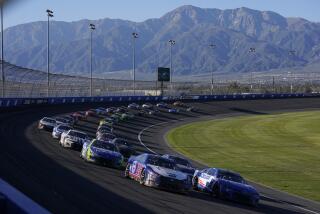Fast and Furious : ENZO FERRARI: The Man, The Cars, The Races, The Machines, <i> By Brock Yates (Doubleday: $21.95; 455 pp.)</i>
In the early 1970s, when Enzo Ferrari withdrew from less prestigious racing events to concentrate on Formula One competition, a number of the company’s cars became expendable. They were sold to collectors--”privateers,” as automotive journalist Brock Yates calls them--and their subsequent histories say a lot about the Ferrari organization.
One collector reportedly paid $25,000 for a 512M coupe, but on delivery discovered it was not the new model he had ordered but a damaged team car. When he sent it back, the Ferrari factory returned the same auto to him, in somewhat better shape, along with a repair bill of $20,000.
Automobile racing sponsor Roger Penske had somewhat better luck: His $28,000, supposedly new 512S also arrived in bad shape, but after working on the suspension, chassis and engine, he created the fastest Ferrari sport-class car ever to compete professionally. According to Yates, when Ferrari designer Mauro Foghieri looked over Penske’s 512 at the Daytona 24-hour race, he pronounced it the finest Ferrari racer he had ever seen.
These stories attest to some of the less attractive aspects of the Ferrari legend: its arrogance, inflexibility and all-too-frequent ineptness. Yates dwells on these flaws with evident glee, and traces them, rightly it seems, to Enzo Ferrari himself, whom he portrays as extraordinarily vain and willful.
Trained as a race driver, Ferrari was neither automotive engineer nor designer, but he had “a talent for stirring up men,” as Ferrari himself put it--for setting engineer against engineer, driver against driver, with the intention of producing exceptional results.
Scuderia Ferrari was not, consequently, a pleasant place to work, and only occasionally did the pressure generate first-rate cars, but in the end such things didn’t seem to matter to Ferrari. As portrayed by Yates, the commendatore-- Ferrari was given the title early in his career, and here it’s belittled as comparable to “Kentucky colonel”--was interested solely in power, for himself and for his cars. As Ferrari often said, with revealing candor, “I build engines and attach wheels to them.”
Enzo Anselmo Ferrari was born in 1898 to the wife of a lower-middle-class metalworker in Modena. Enzo learned his father’s trade, but following army service during World War I, set his sights on becoming an automobile racer. He tried and failed to get a job with Fiat, but soon found a position with a car dealer.
By 1920 he was a racer/salesman for Alfa Romeo, at the time a small outfit. Ferrari would quickly emerge as a major Alfa dealer, but his true love was racing, and in 1929 he would form a scuderia --racing stable--in association with Alfa.
Ten years later, however, Ferrari was dismissed, following a fatal test crash partly blamed on Ferrari’s willingness to push his drivers to the limit--this time, to beat the hated, brilliant German teams from the likes of Mercedes-Benz. The Ferrari legend began soon thereafter, for he had made enough money by then to manufacture his own racing cars.
This description of Ferrari’s early years is plainly skeletal, and Yates doesn’t add an enormous amount of flesh to these bones. He tells us that Ferrari, who died in 1988, left few documents behind, and that Italians are poor record-keepers, but it’s still surprising how much of “Enzo Ferrari” is based on speculation, gossip, and second-hand information. Yates passes on the rumors that both Ferrari’s wife Laura and son Dino died of syphilis, for example, without providing much evidence, and that seems unfair--especially considering that Yates emphasizes Ferrari’s many sexual liaisons without even hinting at disease.
Clearly Yates is less interested in the man than in his automotive team, whose exploits he chronicles in mind-numbing detail, race after race, season after season, decade after decade. Eventually these descriptions run together--as do the racers themselves, literally: The book’s body count (if you include spectators) soars well past 200.
Fortunately, Yates’ tendency to overwrite keeps the book moving along, although not always for the right reasons. He describes the final laps of the 1957 German Grand Prix, in which two Ferrari drivers were pursued by the great Juan Manuel Fangio aboard a Maserati, as follows: “Two Rip Van Winkles hounded by the Headless Horseman, they skidded and bounced around the ghostly place, the shriek of their Jano V8s slowly being battered away by the baleful yowl of Colombo’s venerable straight-6.” As the New Yorker would say, Block that metaphor!
“Enzo Ferrari” is hardly a definitive biography, but one does get a strong sense of the man. By insisting that his company race on the international level regardless of the competitiveness of his cars, Ferrari became an Italian icon; by putting racing first without apology, he managed to make his cars attractive to both superior racers and rich amateurs who didn’t care that Ferraris bought for street use were often poorly made.
Ferrari, in short, transformed his personal imperiousness into a marketing device, using his deeply unromantic view of the world to produce some of the most romantic cars ever built. That irony lies at the heart of “Enzo Ferrari,” and nowhere is it better illustrated than in the controversy over the fate of the original Scuderia Ferrari garage:
When it was scheduled to be torn down in the 1980s, historians and car enthusiasts protested, but not the commendatore ; he was, in fact, behind the demolition. Where automotive racing history was once made you’ll now find, ironically, a concrete parking garage.
More to Read
Go beyond the scoreboard
Get the latest on L.A.'s teams in the daily Sports Report newsletter.
You may occasionally receive promotional content from the Los Angeles Times.










